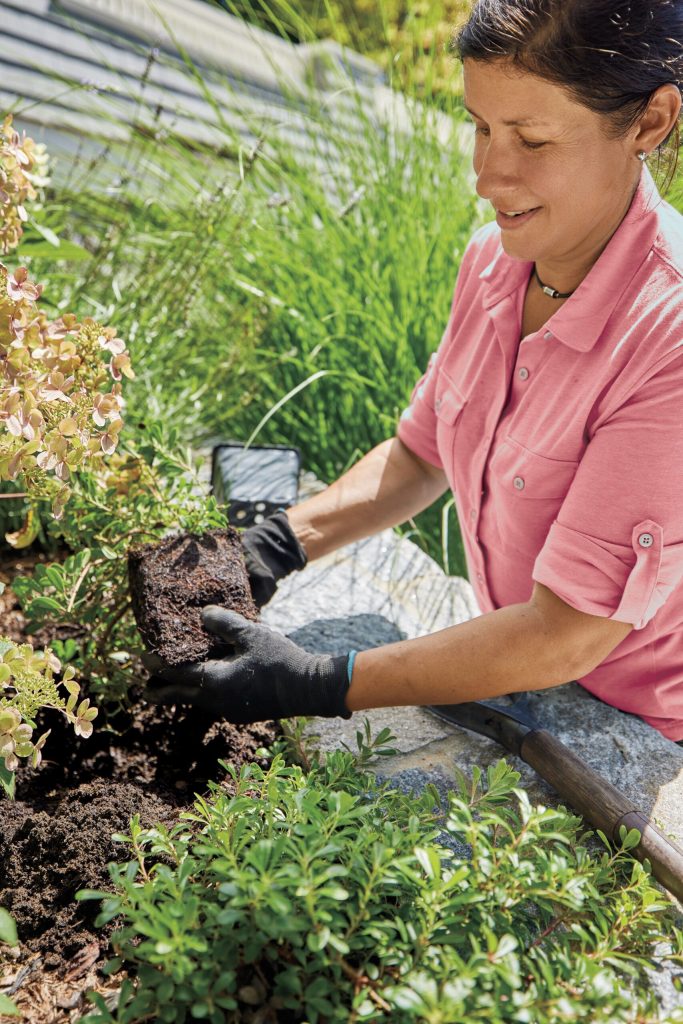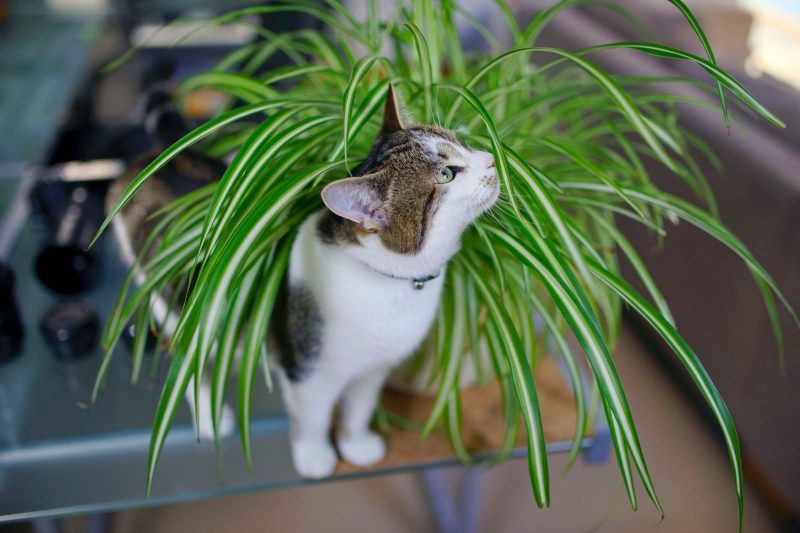Creative Groundcover Combinations

This article appeared in the Summer 2022 issue of This Old House Magazine.
Workhorses in the landscape, groundcovers spread to knit a tight, low-maintenance carpet of foliage that densely covers bare earth. Not just pleasing to look at, they serve a number of practical purposes as well: “Groundcovers can stabilize the soil, help it retain moisture, and prevent weeds from taking hold,” says TOH landscape contractor Jenn Nawada, who prefers them to mulch where she knows they will thrive.
And while there are times when filling a bare spot with a swath of a single plant provides a welcome rest for the eye, she loves the idea of combining two or more species for a pleasing mix of foliage shape, color, and texture, turning groundcovers into a design tool rather than just a backdrop.
What is a Groundcover Plant?
The most familiar are low-growing, creeping perennials that spread densely. Most of these have horizontal stems, either above or below the soil, that spread in all directions, sending down roots and sending up shoots as they go, like the familiar periwinkle and pachysandra. But taller clumping perennials, including hostas and some ferns, also fulfill this role. These plants expand in size more slowly by getting just a little wider each year. Consider working in flowering perennials that spread to a dense, hefty stand, too, such as lady’s mantle, epimediums, and coral bells.
Of course, groundcover plants are generally grown for their foliage and bloom for only a short window each season. So it’s most important to consider the texture of groundcovers’ foliage and the color and sheen of their leaves when putting them together, like the fuzzy silver leaves of lamb’s ears and the rounded, shiny deep-green leaves of European wild ginger. If flowering is also important to you, consider combining groundcovers that have different bloom times so that as one fades, another takes its place in the spotlight.
Keep in mind that groundcovers that spread tend to be more aggressive than the clumping kind, and may out-compete them over time. A pairing of two spreaders might need some refereeing— by yanking out a section or two each season—if one starts outpacing the other. You’ll also want to check the database at invasive.org to see if a plant is invasive in your area before planting.
Sun Seeking Groundcovers
Most full-sun plants need at least 6 hours of direct sun a day, preferably strong afternoon light.
- Creeping phlox (Phlox subulata cvs.) – Grows up to 6 inches high and 24 inches wide in zones 3-8.
- Hens and chicks (Sempervivum tectorum cvs.) – Grows up to 6 inches high and 12 inches wide in zones 4-8.
Why they pair well: These creeping heat and sun lovers are tough and beautiful; they look great in rocky crevices. This particular phlox blooms brilliant pink in early spring; when the flowers are done, they leave behind a dense, clean mat of feathery medium green foliage that’s a great contrast to the fleshy, red-tinged rosettes of the succulent hens and chicks.
- Sea holly (Eryngium x zabelii) is a clump-forming perennial or biennial; it grows up to 24 inches high and 24 inches wide in zones 5-8.
- Lamb’s ears (Stachys byzantina) is a creeping perennial; it grows up to 18 inches high and 24 inches wide in zones 4-8.
Why they pair well: Both of these plants love the baking sun and well-drained soil. Silvery, fuzzy-leaved lamb’s ears is a moderate spreader, so it won’t overwhelm the spiky-looking sea holly over time. The contrast in textures is dramatic, but the plants’ cool colors are soothing on a hot summer day.
- Woolly thyme (Thymus pseudolanuginosus) grows up to 3 inches high and 18 inches wide in zones 5-8.
- ‘Dragon’s Blood’ sedum (Sedum spurium ‘Dragon’s Blood’) grows up to 6 inches high and 24 inches wide in zones 4-9.
Why they pair well: These creeping low growers are perfect at the edge of a bed near a sunbaked walkway. The thyme blooms in late spring to early summer with a frosting of pink flowers; the sedum blooms deep red later in the season. The sedum’s frilled green-to-burgundy foliage offers an interesting counterpoint to the thyme’s tiny, velvety green leaves.
- Cranesbill (Geranium x cantabrigiense) is a creeping perennial that grows up to 12 inches high and 24 inches wide in zones 5-8.
- Catmint (Nepeta x faassenii) has small, fuzzy gray-green leaves; it grows in clumps up to 24 inches high and 36 inches wide in zones 4-8.
- Lady’s mantle (Alchemilla mollis) is a clumping perennial with broad scalloped leaves; it grows up to 24 inches high and 30 inches wide in zones 4-7.
Why they pair well: There’s a spectacular moment in early summer when all three bloom at once, as shown here; each then blooms sporadically throughout the season. Adaptable by nature, all three tolerate both sun and partial shade. When not in bloom, their foliage offers a perfect mix of mounded textures.
Made for the Shade
Partial- or full-shade plants prefer no more than 3 to 6 hours of sun, preferably weak morning light
- Common periwinkle (Vinca minor) grows 4-8 inches high and indefinitely wide in zones 4-9.
- ‘Catlin’s Giant’ bugleweed (Ajuga reptans ‘Catlin’s Giant’) grows up to 6 inches high and indefinitely wide in zones 3-9. WHY THEY PAIR WELL This combo will grow in your most challenging spot. Both like partial to full shade, thrive in any soil, and will cover a slope where grass won’t grow. These strong spreaders will compete for space, especially with a bit of sun, though more light equals more blue flowers. Take care not to grow vinca, which is invasive in parts of the eastern United States, where it risks running into open woodland.
- Hosta (Hosta cvs.) comes in a large range of sizes and shades of green and thrives in zones 3-8.
- Bunchberry (Cornus candensis) grows up to 9 inches high and indefinitely wide in zones 2-7.
Why they pair well: Both prefer full shade and moist, well-drained soil. The native, low- and slow-growing bunchberry, actually a creeping dogwood, forms an attractive carpet under virtually any hosta, which grows in clumps. The plants’ leaves are similarly shaped and grooved for textural harmony, with the dogwood’s white flowers adding a bright note in late spring.
- Big Blue’ lilyturf (Liriope muscari ‘Big Blue’) grows up to 12 inches high and 18 inches wide in zones 6-10.
- Autumn fern (Dryopteris erythrosora) slowly grows up to 2 feet high and wide in zones 6-9.
Why they pair well: Both thrive in partial to full shade and moist, fertile, well-drained soil. Lilyturf is a yard staple for its clean, grassy texture and long-lasting spikes of blue or purple flowers in late summer to fall. Adding a splash of a contrasting color, like this stand of bright-green autumn fern, sets off its color even more.
- Lady’s mantle (Alchemilla mollis) grows up to 24 inches high and 30 inches wide in zones 4-7.
- Sweet woodruff (Galium odoratum) grows 6-12 inches tall and indefinitely wide in zones 5-8.
Why they pair well: Both thrive in partial shade and rich, moist, well-drained soil but can also tolerate indirect sun. A creeping perennial, sweet woodruff produces delicate whorls of emerald-green foliage that are topped with tiny, starry white flowers in spring. They offer a wonderful complement to the larger, pale green, scalloped round leaves of lady’s mantle, a clumping perennial that produces tiny chartreuse flowers in summer after the sweet woodruff’s flowers have faded away.
1. Variegated Solomon’s seal (Polygonatum odoratum ‘Variegatum’) grows up to 36 inches high and indefinitely wide in zones 4-8.
2 & 3. Lungworts (Pulmonaria cvs.) grow up to 18 inches high and 24 inches wide in zones 3-8.
4. European wild ginger (Asarum europaeum) grows up to 6 inches high and 18 inches wide in zones 4-8.
5. Japanese painted fern (Athyrium niponicum var. pictum ‘Metallicum’) slowly grows 8-12 inches high and indefinitely wide in zones 5-8.
Why they pair well: These classic shade perennials offer a range of hues, from bright chartreuse to glossy deep, dark greens, interesting variegation, and a variety of leaf shapes and forms that play off one another beautifully.
1. Common Solomon’s seal (Polygonatum x hybridum) grows up to 3 feet high and indefinitely wide in zones 6-9.
2, 3, & 4. Barrenworts (Epimedium x versicolor cvs.) grow up to 12 inches high and 18 inches wide in zones 5-9.
Why they pair well: Epimediums are spreading woodland perennials that produce delicate, spidery spring flowers in a variety of colors; their dense, cascading foliage ranges from pale green to burgundy, with lots of variation in between, and is evergreen except during the harshest winters. Backing them up with the arching stems and dangling white spring flowers of Solomon’s seal, another spreader, gives them an added boost of interest.
Tips for Planting Groundcover
Plan Your Spacing
There are three factors to consider when spacing groundcovers in preparation for planting: the plant’s ultimate size, its growth rate, and your patience. For instance, European wild ginger spreads 18 inches wide but isn’t a particularly fast grower.
So if you want quicker coverage, you may want to plant it every 12 inches. Bugleweed, on the other hand, is an aggressive spreader; spacing these plants farther apart is just fine, and saves you money. In such cases, Jenn says, “Don’t go for immediate gratification. Space them out and let them fill in.”
Prepare the Soil
No matter how far apart you plant groundcovers, prepare the ground carefully first to give them a good start. Turn over the soil and remove any weeds and roots before smoothing it out and laying out the plants in a grid until the spacing is right; then plant and water well.
Give Them a Good Start
Newly planted groundcovers will need a bit of coddling to become the low-maintenance workhorses that they will ultimately be. Water regularly and fertilize occasionally to help them to establish strong root systems, and weed in between them meticulously. Before long, they will crowd out those weeds







